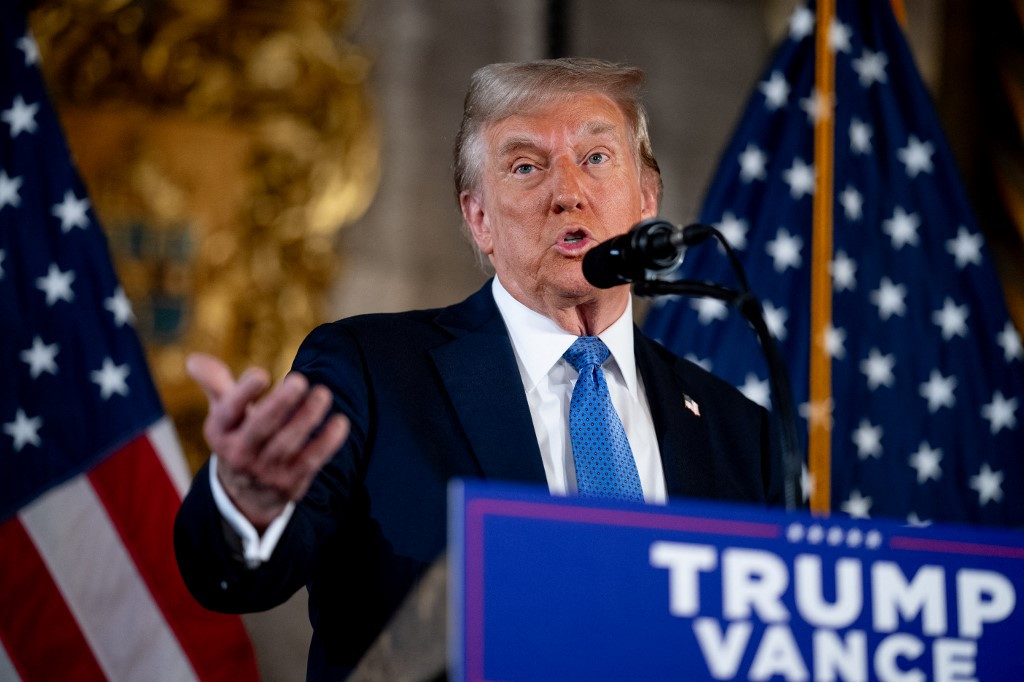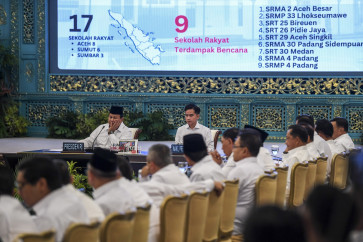Popular Reads
Top Results
Can't find what you're looking for?
View all search resultsPopular Reads
Top Results
Can't find what you're looking for?
View all search resultsA retrospective on Trump's first year back
No one can know what US president-elect Donald Trump will do, but one can speculate.
Change text size
Gift Premium Articles
to Anyone
P
redictions about 2025 come with flashing caveats: no one can know what United States president-elect Donald Trump will do, let alone how the rest of the world will respond. But one can speculate. Imagine it is January 2026.
As 2025 began, the mood of the American business community shifted. Some businesspeople had long harbored private doubts about Trump’s anti-globalization campaign. But overall confidence began to fall when they came face to face with the possible consequences of cutting the US economy off from international trade and migration: sharply higher prices of imported products and labor shortages in some sectors.
Public anxieties multiplied as mysterious cyber-attacks caused a series of failures affecting US power infrastructure and water and sanitation systems. Some childhood diseases like measles returned. From Inauguration Day, social media hesitated to highlight efforts by public-health and information-technology professionals to correct the accompanying misinformation.
Most dramatic in the first half of 2025 was the correction in the US stock market, with the S&P 500 index down by around 35 percent. To be sure, the market had been ripe for a correction. The S&P 500 had increased sevenfold between January 2009 and the 2024 election, fueled by stronger-than-expected growth in US output and employment in 2021-24. By the end of President Joe Biden’s term, stocks had entered bubble territory. Whether evaluated relative to earnings, dividends, capital stock replacement value, or GDP, share prices had reached levels reminiscent of 1929 and other pre-crash episodes.
But it took a needle to prick the bubble. Having gained majorities in the Senate and the House of Representatives, the Republicans also gained responsibility for producing a federal budget. But they were split: while they agreed that the US was on an unsustainable fiscal path, they disagreed on the solution. One faction touted lower taxes as the key to fiscal virtue, and the other, spurred by Elon Musk, emphasized spending cuts.
Budget negotiations devolved into an all-too-familiar game of chicken. When neither side flinched, the US faced a fiery collision, in the form of a month-long government shutdown and credit downgrades by all three major ratings agencies, which in turn crashed stock and bond markets.
As the year drew to a close, some observers argued that the US is in recession. In any case, rising inflation, fueled by Trump’s tariffs and his attacks on the US Federal Reserve’s independence, augurs the return of 1970s-style stagflation.
At the same time, there was a vast divergence between what Trump’s supporters and opponents expected and what they got in 2025. As it turned out, the business community unexpectedly prevailed on him for higher caps on the number of H-1B visas (for high-skilled workers) and expansion of other legal immigration channels. Trump also re-reversed himself on TikTok. He made big changes to his cabinet, firing Secretary of Health and Human Services Robert Kennedy, Jr., who sought tougher regulations for pharmaceutical companies.
Beyond the economy, Trump took other unexpected steps. His most startling volte-face was his support of states guaranteeing a woman’s right to abortion. He insisted that he has always believed the matter should be decided at the state level.
In terms of foreign policy, one big shock was the first armed US incursion into Mexico in over a century.
Before that, Trump withdrew support from Ukraine, as expected, effectively surrendering to Russia and thereby fatally undermining US credibility in the eyes of potential adversaries, not least Russian President Vladimir Putin himself. Russian troops moved into parts of Georgia and ominously popped up along its 1,500-mile border with NATO, tying down their Western counterparts throughout the year.
With the US distracted, and a new precedent set regarding respect, or the lack thereof, for national borders, Venezuela invaded Guyana, Ethiopia invaded Somalia, and Indonesia invaded Timor Leste. Unencumbered by the 2015 Joint Comprehensive Plan of Action, from which Trump withdrew in 2018, and weakened by the decimation of its proxies in Gaza, Lebanon and Syria, the Iranian regime completed its development of nuclear weapons.
Most alarming, however, were naval actions by China, whether a reaction to its economic downturn, which Trump’s tariffs have exacerbated, or an effort to exploit America’s current weakness. Throughout the year, Chinese forces were active in the waters around Taiwan and on newly fortified islands that it claims in the South China Sea. With Trump’s tough-guy reputation roundly questioned, he surprised everyone when he responded to a ship collision, in which several US sailors were killed, by sending a joint US-Philippine naval force to retake Scarborough Shoal and the Spratly Islands. In a pattern familiar from modern history, the Trump administration carried out a threat of military intervention that it had neglected to signal in advance.
At year end, China’s coast guard appeared to be installing a “quarantine” of Taiwan. Trump has now sent all naval forces the US can spare to break the blockade if necessary. As 2026 gets underway, fears of a hot war between the two nuclear superpowers seem all too real.
Throughout 2025, Trump’s opponents consoled themselves with thoughts of a silver lining: their fellow Americans would finally see the consequences of having such a president. Before long, his influence would plummet, both in Congress and among the electorate, as he spent more time playing golf at Mar-a-Lago.
No such luck. As usual, Trump blames the disruptions and disasters of 2025 on anyone or anything other than himself. Likewise, his supporters do not see the adverse developments of 2025 as his fault. Why should they, when they never have before? True, Trump’s supporters are unable to distill the appropriate lessons from history. But in predicting that they will, his opponents are ignoring history as well.
---
The writer is professor of capital formation and growth at Harvard University, and served as a member of president Bill Clinton’s Council of Economic Advisers. He is a research associate at the US National Bureau of Economic Research.











